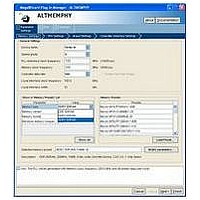IPR-HPMCII Altera, IPR-HPMCII Datasheet - Page 49

IPR-HPMCII
Manufacturer Part Number
IPR-HPMCII
Description
IP CORE Renewal Of IP-HPMCII
Manufacturer
Altera
Datasheet
1.IP-HPMCII.pdf
(176 pages)
Specifications of IPR-HPMCII
Software Application
IP CORE, Memory Controllers, SDRAM
Supported Families
Arria II GX, HardCopy III, Stratix III, Stratix IV
Core Architecture
FPGA
Core Sub-architecture
Arria, HardCopy, Stratix
Rohs Compliant
NA
Lead Free Status / RoHS Status
na
- Current page: 49 of 176
- Download datasheet (4Mb)
Chapter 4: Compiling and Simulating
Compiling the Design
December 2010 Altera Corporation
■
3. Set the top-level entity to the top-level design.
4. Assign the DQ and DQS pin locations.
5. For Stratix III and Stratix IV designs, if you are using advanced I/O timing, specify
Alternatively, to change the pin names that do not match the design, you can add a
prefix to your pin names by performing the following steps:
a. On the Assignments menu, click Pin Planner.
b. On the Edit menu, click Create/Import Megafunction.
c. Select Import an existing custom megafunction and navigate to
d. Type the prefix you want to use in Instance name. For example, change
a. On the File menu, click Open.
b. Browse to your SOPC Builder system top-level design or <variation
c. On the Project menu, click Set as Top-Level Entity.
a. You should assign pin locations to the pins in your design, so the Quartus II
b. Use either the Pin Planner or Assignment Editor to assign the clock source pin
1
The ×4 DIMM has the following mapping between DQS and DQ pins:
■
■
■
■
The DQS pin index in other ×4 DIMM configurations typically increases
sequentially with the DQ pin index (DQS[0]: DQ[3:0]; DQS[1]: DQ[7:4]; DQS[2]:
DQ[11:8])
board trace models in the Device & Pin Options dialog box. If you are using any
other device and not using advanced I/O timing, specify the output pin loading
for all memory interface pins.
<variation name>.ppf.
mem_addr to core1_mem_addr.
name>_example_top if you are using MegaWizard Plug-In Manager, and click
Open.
software can perform fitting and timing analysis correctly.
manually. Also choose which DQS pin groups should be used by assigning
each DQS pin to the required pin. The Quartus II Fitter then automatically
places the respective DQ signals onto suitable DQ pins within each group.
DQS[0] maps to DQ[3:0]
DQS[1] maps to DQ[7:4]
DQS[2] maps to DQ[11:8]
DQS[3] maps to DQ[15:12]
To avoid no-fit errors when you compile your design, ensure that you place
the mem_clk pins to the same edge as the mem_dq and mem_dqs pins, and set
an appropriate I/O standard for the non-memory interfaces, such as the
clock source and the reset inputs, when assigning pins in your design. For
example, for DDR3 SDRAM select 1.5 V. Also select in which bank or side
of the device you want the Quartus II software to place them.
Section II. DDR3 SDRAM Controller with ALTMEMPHY IP User Guide
External Memory Interface Handbook Volume 3
4–3
Related parts for IPR-HPMCII
Image
Part Number
Description
Manufacturer
Datasheet
Request
R

Part Number:
Description:
IP NIOS II MEGACORE RENEW
Manufacturer:
Altera
Datasheet:

Part Number:
Description:
IP CORE Renewal Of IP-XAUIPCS
Manufacturer:
Altera
Datasheet:

Part Number:
Description:
IP CORE Renewal Of IP-10GETHERNET
Manufacturer:
Altera
Datasheet:

Part Number:
Description:
IP CORE Renewal Of IP-ASI
Manufacturer:
Altera
Datasheet:

Part Number:
Description:
IP CORE Renewal Of IP-CIC
Manufacturer:
Altera
Datasheet:

Part Number:
Description:
IP CORE Renewal Of IP-CRC
Manufacturer:
Altera
Datasheet:

Part Number:
Description:
IP CORE Renewal Of IP-ED8B10B
Manufacturer:
Altera
Datasheet:

Part Number:
Description:
CPLD, EP610 Family, ECMOS Process, 300 Gates, 16 Macro Cells, 16 Reg., 16 User I/Os, 5V Supply, 35 Speed Grade, 24DIP
Manufacturer:
Altera Corporation
Datasheet:

Part Number:
Description:
CPLD, EP610 Family, ECMOS Process, 300 Gates, 16 Macro Cells, 16 Reg., 16 User I/Os, 5V Supply, 15 Speed Grade, 24DIP
Manufacturer:
Altera Corporation
Datasheet:

Part Number:
Description:
Manufacturer:
Altera Corporation
Datasheet:










